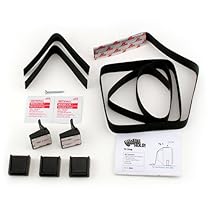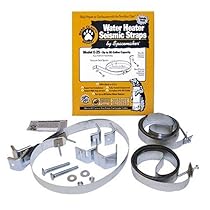by Broderick Perkins
© 2007 DeadlineNews.Com
Deadline Newsroom – Even moderate quakes can turn household items into deadly missiles. Here's how to reduce the chance your stuff will turn against you in a quake.
A recent earthquake hurled hundreds of thousands of library research books to the floor, underscoring the importance of securing household items to prevent them from becoming dangerous missiles during a big trembler.
Shop Earthquake Preparedness
Little damage and few injuries resulted from the 2007 Halloween Eve, magnitude 5.6 quake in Northern California, but seismic shockwaves from the epicenter nine miles to the east of San Jose, CA tossed 300,000 research books and publications to the floor in the city's main Martin Luther King Jr. Public Library.
No one was injured by the books which ended up virtually carpeting the top three floors of the eight-story, four-year old library. The library was constructed with the latest seismic building codes, which otherwise allowed the building to flex, move and survive unscathed, as designed.
While seismic building codes and retrofits can help secure the structure of a building in all but the greatest of earthquakes, a structure's contents need additional attention.
In the 6.7 Northridge, CA, earthquake in 1994, 55 percent of quake-related injuries were due, not to collapsing buildings, but because of falling and breaking objects -- televisions, pictures, mirrors and heavy light fixtures.
The United States Geological Survey's "Putting Down Roots In Earthquake Country" says there's a 62 percent probability that a quake, magnitude 6.7 or greater, will hit the San Francisco Bay Area by 2032.
Another study, "When the Big One Strikes Again" says from 40,000 to 62,000 casualties could result from such a trembler and more than half of those could be caused by seismic energy turning household goods into missiles.
The Association of Bay Area Governments' "Ways to Reduce Damage to and Injury from the Contents of Your Home" explains how to lessen the chance household objects will turn on you during a quake.
• Identify and secure large objects that could fall in a quake. Secure both top corners of tall, top-heavy desks, bookcases and entertainment centers to a wall stud -- not the drywall. Using flexible fasteners will allow the furniture to move independently, without tipping over. The flexibility also reduces strain on the studs. Move heavy objects away from sleeping and sitting areas and clear exit paths of clutter. Fasten down home electronics with flexible nylon straps and buckles.
• Place only soft art above beds and sofas. Glass used for framed and other art can shatter. Consider using clear plastic or acrylic instead of glass for all hanging art. Even then, use closed hook hangers to hang objects and help prevent them from bouncing off the wall. 
• Use removable museum wax or earthquake putty or gel to secure knickknacks, gewgaws, collectibles, lamps, pottery and other objects stored on open shelves and counter tops. Store heavier objects on lower shelves or inside display cases with quake or child-proof latches.
• Likewise, secure kitchen cabinets holding glassware and china, especially overhead cabinets, to prevent items from falling out and breaking during a quake.
• In the garage or storage area, move flammables and hazardous materials to low, secure areas. Make sure items stored above or beside vehicles in the garage cannot fall and damage or block vehicles and escape routes.
• Secure water and gas lines. Learn when and how to shut off water and gas lines. Have a plumber inspect pipelines and replace rusted and worn pipes. A plumber can also swap out rigid gas connections to water heaters, stoves, dryers and other gas appliances with more flexible connectors. Also consider installing excess-flow gas-shutoff valves to stop gas flows when a line springs a potentially deadly leak.
• Secure heavy appliances. Quake country law mandates that water heaters must be anchored to wall studs with metal straps and lag screws. Kits are readily available at hardware stores and home improvement centers. Likewise, secure refrigerators, free standing ranges, microwave ovens and other large, major appliances to walls using earthquake appliance straps.
5.6 Quake Considered 'Moderate'
Largest Bay Area Quake Since Loma Prieta, 1989
A moderate, but long-rumbling earthquake, magnitude, 5.6 earthquake occurred at 8:04 p.m. (PDT) on Tuesday, Halloween Eve, October 30, 2007, 5 miles to the northeast of Alum Rock, CA, an area about 10 miles from San Jose, CA's city center.
Dozens of aftershocks followed in the 1 to 2 magnitude range. The exception was a magnitude 3.7 aftershake, Halloween Day, October 31, 2007, at 3:54 p.m. with a nearly identical epicenter.
Watch the swarm of aftershocks on the US Geological Society's Quake Watch Web page.
Some isolated damage and minor injuries were reported from the initial shaker and both cell phone lines and land line phone service was temporarily interrupted over scattered areas.
(Damage Photos)
The shaker on the Calaveras Fault lasted about 30 seconds and was the most powerful tremblor to hit the San Francisco Bay Area since Loma Prieta, Oct. 17, 1989 quake rumbled through at a magnitude 6.9.
Residents are advised to inspect plumbing lines, especially older plumbling, for hairline cracks or damage. Check both water and gas lines, connections to the water heater and other appliances.
Also, use the quake as a wake up call to get prepared for the Big One. Residents should have an emergency survival kit with enough food, water and other gear to last for three days.
• DeadlineNews.Com Special Report: The Big One -- Are You Ready?
• 'Supercrack' Shakes Up SF Bay Area
• California 'Big One' Sooner Than Expected
• Helping Your Home Survive A Great Quake
• Preparing For A Quake With Four Times Katrina's Destruction
• Great Quake Looms, Many Households Unprepared
© 2007 DeadlineNews.Com
Broderick Perkins, an award-winning consumer journalist of 30 years, is publisher and executive editor of San Jose, CA-based DeadlineNews.Com, a real estate news and consulting service, and the new Deadline Newsroom, DeadlineNews.Com's new backshop. In both cases, it's where all the news really hits home.
DeadlineNews.Com's Editorial Content Is Intellectual Property • Unauthorized Use Is A Federal Crime
Thursday, November 1, 2007
Quake Alert: Secure Household Items
From The
Deadline Newsroom
on
11/01/2007 12:15:00 PM
![]()
Labels: Broderick Perkins, California, Deadline Newsroom, DeadlineNews.Com, disaster, earthquake, emergency kit, preparedness, quake, seismic, survival
Subscribe to:
Post Comments (Atom)



No comments:
Post a Comment